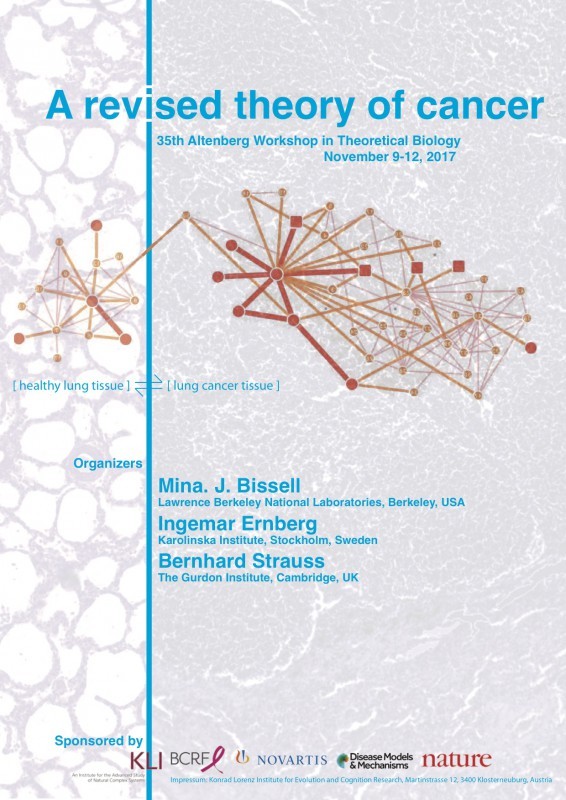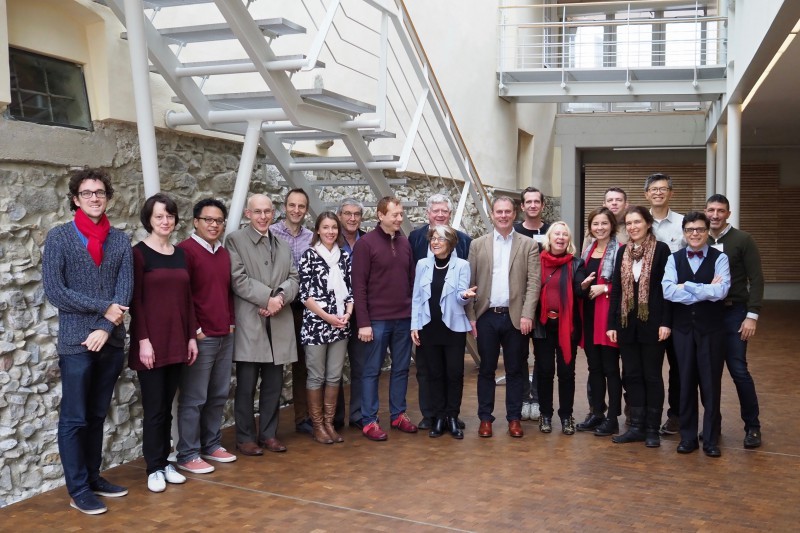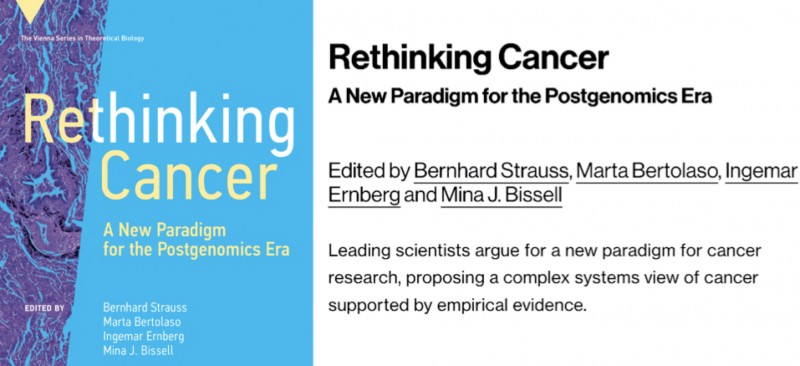News Details

Rethinking Cancer: A New Paradigm for the Postgenomics Era is the latest publication in the Vienna Series in Theoretical Biology at the MIT Press (Amazon preview). The outcome of A Revised Theory of Cancer—a 2017 KLI Altenberg workshop organized by Mina J. Bissell (Lawrence Berkeley National Laboratories), Ingemar Ernberg (Karolinska Institutet), and Bernhard Strauss (University of Cambridge)— this book offers strong empirical and theoretical justification to change the current research paradigm in cancer research dominated by the Somatic Mutation Theory.
Today, we had a video conference with Bernhard Strauss, lead editor of Rethinking Cancer (with co-editors Marta Bertolaso, Ingemar Ernberg, and Mina J. Bissell) to talk about their projects and an exciting event that will take place in September 2021. At the end of this piece, Bernhard offers highlights from each chapter of the book. You can preview the book here on Amazon.
You can also download and read the interview as an epub or pdf.
Lynn: Bernhard, thank you for accepting our interview. I’m curious about the title, in particular, the change from a revised theory of cancer, the title of the initial meeting, to “rethinking” to propose a new paradigm. Can you tell me more about the central motivations behind your project?
Bernhard: The “Rethinking Cancer” project is motivated by our collective recognition that there is currently a lack of theoretical thinking in the cancer field. The term rethinking signals a call for action. We are not offering a new theory to consider, but we are signaling the need to act and revise a paradigm that had been unsuccessful in the past five decades to effectively prevent and treat cancer. We, and many others, have observed over the past decade that all the new -omic advancements have failed to change the same paradigmatic causal theory of cancer—the somatic mutation theory.
Tell us a bit more about the Somatic Mutation Theory (SMT).
In a nutshell, it is the idea that specific genes, when mutated or dysregulated, are responsible for carcinogenesis. Cells with these mutations would have a proliferative advantage, which causes cancer. The somatic mutation theory is an old idea, in its conceptual origins going back at least to the work of Theodor Boveri in 1914, and fully developed in the emerging molecular biology era in the 1970s. Its propagation as a mainstream paradigm happened with the US National Cancer Act of 1971 by the Nixon administration, which became the conceptual blueprint for most later large-scale cancer research efforts internationally. It rests on a simplistic scheme of causality and still informs the way we design cancer treatments today, yet it is incompatible with vast amounts of data we now have that show that cancer causation is not that simple. The “war on cancer” over the last 50 years was bigger than the space program, and indeed we have made some progress, but death rates for late-stage cancers have still not changed much.
There had been several attempts to challenge the SMT and move our understanding of cancer from a cellular to a tissue, or higher level of organization. Why haven’t these attempts succeeded in overturning it?
Indeed, all the while the SMT dogma became dominant, a lot of people have always emphasized that it cannot be that simple. It has become clear that cancer is the result of perturbations in complex reciprocal interactions, involving for example the mechanical properties and extracellular matrix of the tissue microenvironment of cells and tissues. Over the years many individual scientists have published critical views on the gene-centric paradigm in cancer research, as part of the debate around reductionist approaches in science generally, basing their arguments on systems biology or complex systems thinking. A view that we also promote in the book.
However, the war on cancer primarily funded research looking for explanations at the DNA sequence level. The technological advancements in DNA sequencing were overwhelmingly successful, as they look at the most robust molecule we have in the body. It is technically much more difficult to analyze proteins and the tissue level mechanisms of 3D tissue structures. Despite the enormous progress in genomics technologies, which has delivered a wealth of very useful other insights, overall, the cancer field has admitted that simple causal links between genetic mutations and tumor phenotypes don’t exist. In particular, links that could be used for robust diagnosis and treatments.
If advancements in cancer research is largely driven by technological breakthroughs, why would theory help?
We need to turn away from these simple, linear gene-centric causal explanations and find answers at the tissue level, and in understanding the complex dynamical systems that cells are. We have by now enough empirical evidence to show that this is the way forward. To conceptualize such an understanding, and propose experimental approaches built on it, needs theoretical thinking. As the DNA based technologies and DNA based explanations have dominated the field for decades, conceptualizing other levels of causal relevance is indeed a challenge for most cancer researchers.
Let’s talk about some outcomes of your cancer projects! First, the 35th Altenberg workshop meeting at the KLI in 2017 which has led to the publication of this new book “Rethinking Cancer”. How did you put the initial workshop together?
 To discuss any paradigm change it is always good to bring people from very different thinking cultures together, so that the problem that needs discussing can be approached from truly different directions. As organizers of the 35th Altenberg workshop we invited scientists from roughly three main backgrounds, all working on cancer now, namely, theorists, often with a physics or mathematical or network science background, or philosophy of science, then cancer cell biologists who for decades worked on cellular phenomena that clearly show that our current explanations of cancer are very much insufficient, and clinicians who deal on a daily basis with cancer patients, experiencing first hand how the current paradigm is not helping patients.
To discuss any paradigm change it is always good to bring people from very different thinking cultures together, so that the problem that needs discussing can be approached from truly different directions. As organizers of the 35th Altenberg workshop we invited scientists from roughly three main backgrounds, all working on cancer now, namely, theorists, often with a physics or mathematical or network science background, or philosophy of science, then cancer cell biologists who for decades worked on cellular phenomena that clearly show that our current explanations of cancer are very much insufficient, and clinicians who deal on a daily basis with cancer patients, experiencing first hand how the current paradigm is not helping patients.
I see that you invited philosophers as well. What is the role of the philosopher or historian in theory building?
When planning the initial workshop we wanted to have philosophers of science on board, and interestingly there are now quite a few who explicitly have been working on cancer for around a decade. This was important to us, because the historical and the philosophical perspective can really present a different analytical outside view of the whole field of cancer research. And also make clear that in this as in any other field of science, whatever is “the current thinking”, is not some infallible truth, but the result of certain historic events and decisions. And of course, some of these decisions were investment decisions, because, ideas that receive the most funding are most likely to dominate the thinking of the whole field. So, I believe that philosophers of science have really helped defining the conceptual issues, the real problems with the explanatory logic of the current cancer research paradigm. And also by making it explicit, that having a paradigm crisis is a well-understood phenomenon that happened many times before in the history of science. This knowledge can then also inform novel thinking that should lead to a way out of the crisis, and a true paradigm shift.
What was the workshop like, what stood out for you? What inspirations did it trigger?

What was great at the workshop was that despite these very different backgrounds there was immediately a very good sense of common understanding, and urgency, that indeed cancer research badly needs to change some very fundamental scientific assumptions to make more progress. A few participants commented on this tangible sense of common purpose, and a very good focused “energy in the room.” A few experimental scientists told me a year later that they came away with novel ways of doing experiments, and a few collaborations between people who did not know each other before came about as a result of the workshop. I remember one participant told me in the restaurant in the evening that he would do things differently now in his lab, because of what Thea Newman, a physicist, said about water in a glass, and how physical explanations of water have to do with understanding cancer. It is this kind of seminal cross-disciplinary encounter that is really the ideal outcome of these workshops.
I think, that the good memories of these three very creative and interactive, but also very intense days at the KLI also helped with the motivation to then also contribute and work on the book. Book chapters are usually not well regarded in the science community, because they do not add to any career impact factor, so are often considered a waste of time. But I have to say that all contributing authors really have created truly original chapters, some of them formulating novel conceptual thinking for the first time. It was a great pleasure to work together with all of them, and my impression was that again there was a common sense that this should become a landmark book for the cancer research community. And so far, quite many readers have just said that.
We’re very pleased to hear that the KLI could enable such a stimulating environment. Before we give the readers highlights of each chapter, could you tell us about your next steps regarding the “Rethinking Cancer” agenda?
Now that the book has come out this April, we are planning a follow-up meeting, in London this time, at the Royal Society of Medicine, on the 22nd and 23rd of September. The meeting really has two main goals, one is to take stock after almost four years since the 35th Altenberg workshop, as a lot has happened since then, scientifically, as well as in terms of a further increase in voices, meetings and publications, critical of the current paradigm. And secondly, we would like to really get away this time with some very tangible next steps towards implementing a new paradigm in cancer research. To help with that we have invited again a group of very original thinkers, from a similar range of backgrounds as at the last meeting, theoreticians, experimental scientists, clinicians, people who are really opening up new ways forward in our understanding of cancer.
Thank you, Bernhard. This was a fantastic conversation. We look forward to seeing what your group will do next, so please keep us updated!
Chapter highlights

Amazon preview link.
I) The Theory Dimension of Cancer:
Chapter 2. The search for progress and a new theory framework in cancer research
Historical reasons for and philosophical analysis of the current, dominant scientific paradigm in cancer research. Proposing a new epistemological framework for novel approaches to explain and cure cancer. M. Bertolaso & B. Strauss
Chapter 3. Cancer as a system: hard lessons from physics and a way forward
Presents examples from physics of how complex phenomena, such as cancer, can be understood by selecting the right “entity identity” that has explanatory causal relevance for the phenomenon in question. T. Newman
II) The Systems Dimension of Cancer
Chapter 4. The logic of cancer treatment: why it is so hard to cure cancer
Shows how concepts from complex dynamical systems theory can explain the cancer phenotype as well as the fact that cancers after treatment often recur more aggressive. S. Huang
Chapter 5. The cell attractor concept as a tool to advance our understanding of cancer
Explains how the cellular attractor concept proposed fifty years ago, can today be observed experimentally with single cell analysis technologies, and how it explains cellular decision making in carcinogenesis. I. Ernberg
Chapter 6. Adaptation of molecular interaction networks in cancer cells
Describes how specific structural features of cellular interaction networks determine their overall behavior, for example in response to cancer treatment interventions. Surprisingly, to achieve certain treatment goals it is often more efficient to target not the most affected genes in a network, but neighbors that have an indirect effect. P. Csermely
Chapter 7. The role of genomic dark matter in cancer: using AI to shine a light on it
Make the point that our focus on specific “cancer genes” to explain cancer misses regulatory mechanisms that might be important for cancer initiation present in non-coding parts of the genome. They give an overview of some AI tools to study the non-coding DNA space in our genome. K. Rhrissorrakrai & L. Parida
III) The Time Dimension of Cancer
Chapter 8. Darwinism, Not Mutualism, for New Cancer Therapies
Point out that cancer evolution modelling needs to embrace a truly Darwinian approach, rather than focusing solely on mutation analysis. They suggest that selective forces in carcinogenesis need to be understood and therapies be targeted to evolutionary processes such as diversification early in the disease. J. Scott, D. Basanta, and A. Marusyk
Chapter 9. Cancer as a reversion to an ancestral phenotype
Propose that the cancer phenotype can be understood as a reversion of cellular behavior to a unicellular mode of operation, based on activation of also evolutionary ancient genes. They present empirical evidence that indeed evolutionary gene age correlates with increased expression in different cancers. K. Bussey & P. Davies
Chapter 10. Time and timing in oncology: what therapy scheduling can teach us about cancer biology
Presents a mathematical model to explain tumor growth dynamics and the fact that treatment response of tumors depends on their 3D geometry. In addition, he provides empirical and theoretical arguments that highlight the importance of therapy timing for it to be effective. His hypothesis of tumor growth by “self-seeding” with metastatic cells explains growth dynamics observed in breast cancer. L. Norton
IV The Micro-/Environment Dimension of Cancer
Chapter 11. Tissue tension modulates metabolism and chromatin organization to promote malignancy
Show how the mechanical properties of cancer tissues influence their metabolic signaling and lead to overall chromatin restructuring causing global gene expression changes characteristic for cancer cells. R. Oria, D. Thakar, and V. Weaver
Chapter 12. Cancer metabolism and therapeutic perspectives: exploiting acidic, nutritional, and oxidative stresses Demonstrate that cancer cells can undergo a wide range of metabolic adaptations utilizing non-standard pathways for energy production that allow them to survive in often extreme tumor-microenvironments of low pH, low O2, and lack of nutrients. These cancer specific adaptations can be utilized for treatment approaches. M. Ždralevic & J. Pouysségur
Chapter 13. Corrupted vascular tumor niches confer aggressiveness and chemoresistance to neoplastic cells Describe how cancers of the blood are caused by changes in the micro-environmental niche in which blood cells mature, and how endothelial cells in the microvasculature of these niches constantly maintain normal niche parameters by local signaling interactions that might be targeted for cancer treatments. L. V. Cappelli, L. Yoffe, and G. Inghirami
Chapter 14. Metastasis asa tug of war between cell autonomy and microenvironmental control: readdressing unresolved questions in cancer metastasis
Demonstrate with clinical and single cell analysis data how our understanding of metastasis needs to be fundamentally updated in order to make more progress in preventing it. They show that metastasis is a very early event in carcinogenesis and that therefore also diagnosis and treatments need to target metastatic cells early in the disease. C. König & C. Klein
Chapter 15. Niche reconstruction to revert or transcend the cancer state
Presents evidence that the specific site of histological origin of cancer cells is more predictive of cancer type and disease progression than mitotic signatures. She postulates that cancer types represent tissue specific “units of selection”, and that tumor niches at the tissue level can be influenced and “reverted” to a healthy state by higher order niches within the organism as well as by the behavioral and social niches that the organism inhabits. E. W. Verschuren
interview by Lynn Chiu

